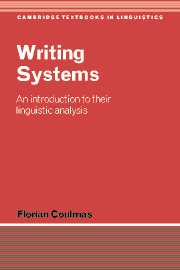Book contents
- Frontmatter
- Contents
- List of illustrations
- List of tables
- Acknowledgements
- A note on fonts
- List of abbreviations and conventions
- 1 What is writing?
- 2 The basic options: meaning and sound
- 3 Signs of words
- 4 Signs of syllables
- 5 Signs of segments
- 6 Consonants and vowels
- 7 Vowel incorporation
- 8 Analysis and interpretation
- 9 Mixed systems
- 10 History of writing
- 11 Psycholinguistics of writing
- 12 Sociolinguistics of writing
- Appendix: Universal Declaration of Human Rights, article 1
- Bibliography
- Index of names
- Index of subjects
8 - Analysis and interpretation
Published online by Cambridge University Press: 05 June 2012
- Frontmatter
- Contents
- List of illustrations
- List of tables
- Acknowledgements
- A note on fonts
- List of abbreviations and conventions
- 1 What is writing?
- 2 The basic options: meaning and sound
- 3 Signs of words
- 4 Signs of syllables
- 5 Signs of segments
- 6 Consonants and vowels
- 7 Vowel incorporation
- 8 Analysis and interpretation
- 9 Mixed systems
- 10 History of writing
- 11 Psycholinguistics of writing
- 12 Sociolinguistics of writing
- Appendix: Universal Declaration of Human Rights, article 1
- Bibliography
- Index of names
- Index of subjects
Summary
The linguistic level at which a script can be seen as linear is logically distinct from the linguistic level of the units that it encodes.
Alice FaberThe genius of analysis that the Korean alphabet represents remains undiminished.
S. Robert RamseyDissection and linearity
All writing systems incorporate linguistic analysis, and all writing systems are linear. This chapter deals with how these two universal properties interact. It will be shown that analyticity and linearity can be, and often are, manifest on different levels. Recognition of this fact helps to resolve a number of confusions about the proper classification of some writing systems, such as the Indian scripts discussed in the previous chapter. To say that writing systems incorporate linguistic analysis does not mean that first there was a proper analysis of speech and then there was writing. It just means that dissection of the stream of speech into constituent parts is indispensable for writing to occur. Only a few writing systems are the result of deliberate design and can accordingly be said to represent linguistic features that were found suitable for recording the language in question. More commonly, the interpretation of written signs and the analytic understanding of linguistic structure have advanced together, one contributing to the other. A linguistic fit thus evolved. This explains the great diversity of the world's writing systems, which tend to highlight different units, reflecting the linguistic environments in which they developed.
- Type
- Chapter
- Information
- Writing SystemsAn Introduction to Their Linguistic Analysis, pp. 151 - 167Publisher: Cambridge University PressPrint publication year: 2002



